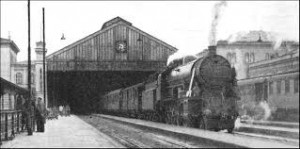
Bram Stoker’s Dracula is cluttered with references to cutting edge technologies of the late Victorian era. For modern audiences this might seem quaint or superficial, but there is a deeper significance to these references. Stoker utilizes technology in his narrative to strengthen the novel’s thematic struggle between science and spiritualism. Stoker’s character’s alternating use of modern technology and rudimentary tools creates an effective foil to convey the contrasting impulse to modernize and the necessity of traditional items. This struggle is important to recognize and discuss because it gives modern audiences a sense of confusion and unease felt during late Victorian and Edwardian era debates over technological advancements and the displacement of man.
Technology, the application of science and engineering for the betterment of humanity, figures into the novel through Dr. Seward’s phonograph, telegrams, blood transfusions, and trains. Technology even becomes part of a competition within the novel as our heroes race Dracula’s sail-powered ship with a steam-powered locomotive (Stoker, 354). Needless to say, the locomotive prevails. Technology aids the heroic band on their quest to destroy the titular character, yet there is a concern voiced by Dr. Van Helsing that for all its worth, when science cannot explain something it disregards it as an anomaly (Stoker, 204). After this speech, the characters vow to “believe” and a shadow of doubt is cast over the centrality of scientific method and reasoning. This doubt is difficult for modern audiences considering the advances made in the century since Dracula’s publishing. After all, should there not be more doubt placed upon the existence of omnipotent, evil-doing, undead counts than on the limits of scientific comprehension. At this point, it is necessary to introduce the foil for technology found within spiritualism and its associated motifs.
To compensate for science’s limitations, Van Helsing utilizes religious objects and hypnotism in the pursuit of Dracula. Armed with crucifixes, garlic, communion wafers, and a Nepalese knife, Van Helsing’s band of gentlemen attack Dracula and force him from London (Stoker, 326). While preparing to depart, Van Helsing hypnotizes Mina as a means to stay in contact with the count and reveal his location (Stoker, 332). This blend of science and pseudoscience must have bewildered Victorian audience as much as it bemuses modern ones. The gothic motifs found in crucifixes strike a curious contrast to phonographs. On a more metaphysical and historical level, this contrast represents a tension found in Victorian society. Victorians found themselves on the cutting edge of technological development, but had yet to rid themselves of pseudoscience and superstition. This brackish conflation made it difficult to demarcate where knowledge or truth could be found in their society. There also seems to be an apprehension for technological development. Although some of the characters are reliant on modern gear, whether it is a phonograph or repeating rifle, they still need the aid of hypnotism, a spiritualist relic, to guide them to their quarry and simple communion wafers for protection. In this context, Stoker is able to convey the struggle between modernity and spiritualism.